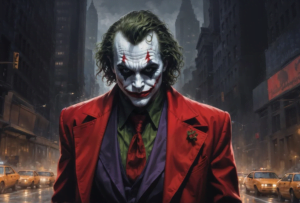In “Joker: Folie à Deux,” Todd Phillips delivers an intense sequel that continues the psychological exploration of Arthur Fleck, a character brilliantly portrayed by Joaquin Phoenix. The movie begins in the aftermath of the chaotic events from the first film, where Fleck’s transition into the Joker led to widespread violence in Gotham City. Now imprisoned at Arkham Asylum, Arthur has become something of a counter-cultural icon, his crimes gaining him the admiration of those on society’s fringes. This notoriety marks the beginning of the film, with Arthur navigating his newfound celebrity while dealing with the torment of being incarcerated. These opening lays the groundwork for a deeper examination of his psyche, with the introduction of a key character—Harleen Quinzel, played by Lady Gaga—who will shape the story’s tragic trajectory.

The World of Arkham and the Introduction of Harleen Quinzel
The film’s first act unfolds within the walls of Arkham Asylum, where Arthur is a man conflicted by his fame and insanity. The asylum is a grim, claustrophobic environment, a direct reflection of Arthur’s inner turmoil. Phoenix’s portrayal of Fleck is a continuation of the character’s unhinged persona, though there are moments of restraint, especially in the beginning where Arthur appears medicated, his infamous fits of uncontrollable laughter stifled.
Enter Harleen Quinzel, a psychiatric intern at Arkham who quickly becomes obsessed with Arthur. Lady Gaga brings a sharp intensity to the role of Harleen, her character both fascinated and infatuated with Arthur’s notoriety. While the original Harley Quinn (from the comic and animated universe) is often depicted as an energetic, whimsical figure, Gaga’s interpretation is darker, more grounded in psychological realism. The chemistry between Fleck and Quinzel is palpable from their first encounter, though it is far from a traditional romance. Their relationship is built on a mutual understanding of isolation and societal rejection. Harleen, already teetering on the edge of madness, is drawn to Arthur’s chaotic energy.
As the two begin to interact more, Harleen’s transformation into Harley Quinn begins. The film does not rush this development, instead slowly unraveling her descent into madness, paralleling Arthur’s own spiral from the first film. The turning point in their relationship comes through an impromptu musical number, with Arthur and Harleen performing a haunting rendition of Close to You by Burt Bacharach, as their bond tightens over their shared disillusionment with the world. This musical interlude is one of many that marks the tonal shift of the film compared to the first Joker, blending psychological drama with surreal musical moments that mirror the fractured mental states of the characters.
The Rebirth of Joker and Harley
The second act focuses on the dark romance between Arthur and Harleen, and it’s here that the film truly begins to diverge from the traditional superhero narrative. Much like in One Flew Over the Cuckoo’s Nest, Arthur remains a symbol of rebellion within the asylum, but Harleen represents something new: the possibility of escape and reinvention. Their relationship becomes a dangerous game, with Harleen becoming more enraptured by Arthur’s philosophy of embracing chaos and disorder. Gaga’s performance as Harley is a standout, particularly during moments when she teeters between empathy and malice, drawing out Arthur’s dormant Joker persona.

Arthur, on the other hand, is torn between the fleeting stability he’s achieved through medication and the allure of returning to his Joker identity, which brought him not only infamy but a twisted sense of purpose. This internal conflict adds a layer of complexity to Phoenix’s performance, as Arthur struggles with whether to let his Joker persona consume him entirely or to try to live as Arthur Fleck.
The musical sequences, though sparse, offer insight into the characters’ mental landscapes. One notable scene sees Arthur perform For Once in My Life in a fantasy sequence where he imagines a world where he and Harleen can live without restraint, completely free of the asylum’s grip. These sequences are not typical Broadway-style numbers but rather eerie, surreal performances that blur the line between reality and fantasy, underscoring the characters’ psychological disintegration.
The final act of Joker: Folie à Deux shifts from Arkham to a tense courtroom drama. Arthur is brought to trial for his crimes, with Catherine Keener playing his defense attorney, who tries to argue that Arthur’s actions were a result of his psychological abuse and upbringing. Here, the film touches on themes of accountability and mental illness, questioning whether Arthur’s insanity should absolve him of his horrific acts.
The district attorney, portrayed by Harry Lawtey, argues that Arthur is fully aware of his actions and deserves the death penalty. Arthur, however, remains torn. On the one hand, he knows that pleading insanity is his only chance at survival, but on the other, he yearns to embrace his Joker identity fully, which brought him love and attention. Harleen, now fully transformed into Harley Quinn, becomes a key player in this act, using her newfound influence to orchestrate a chaotic escape plan.
In the courtroom, Arthur gives a chilling monologue, reflecting on how society failed him and how his embrace of madness has given him freedom. This climactic moment is punctuated by another musical performance, blending elements of a farcical Foghorn Leghorn-style courtroom with deeply disturbing undertones, as the film builds toward its inevitable crescendo.
The final showdown is not a grand superhero battle, but rather an intimate confrontation between Arthur, Harley, and the judicial system that seeks to contain them. The film’s climax, while not as shocking as the talk-show murder from the first Joker, carries emotional weight, with Arthur finally choosing to embrace his Joker persona fully, rejecting the last vestiges of Arthur Fleck. Harley, too, solidifies her role as his partner-in-crime, setting the stage for future chaos.
Also Read: Pixels and Perils: A Minecraft Journey

Conclusion: A Distorted Musical Legacy
Joker: Folie à Deux is not a typical comic-book film. It eschews the tropes of superhero movies in favor of a deeply psychological, character-driven narrative that uses music as a window into the minds of its broken protagonists. While the film’s pacing falters in the second half, and some of the musical numbers feel disjointed, it offers a fascinating glimpse into the psyches of two of Gotham’s most infamous villains. Phoenix and Gaga deliver haunting performances that explore the thin line between madness and sanity, love and destruction.
This sequel may not surpass the first Joker in its visceral impact, but it certainly stands as a bold experiment in genre-blending, offering audiences a tragic love story that unfolds in the darkest corners of Gotham City. Whether future films will further explore the Joker and Harley Quinn’s twisted romance remains to be seen, but Folie à Deux solidifies them as one of the most compelling and dangerous duos in comic-book cinema.
Also Read: Unveiling the Tragedy: A Summary of the Georgia High School Shooting Incident
Please like and subscribe news letter to stay updated!